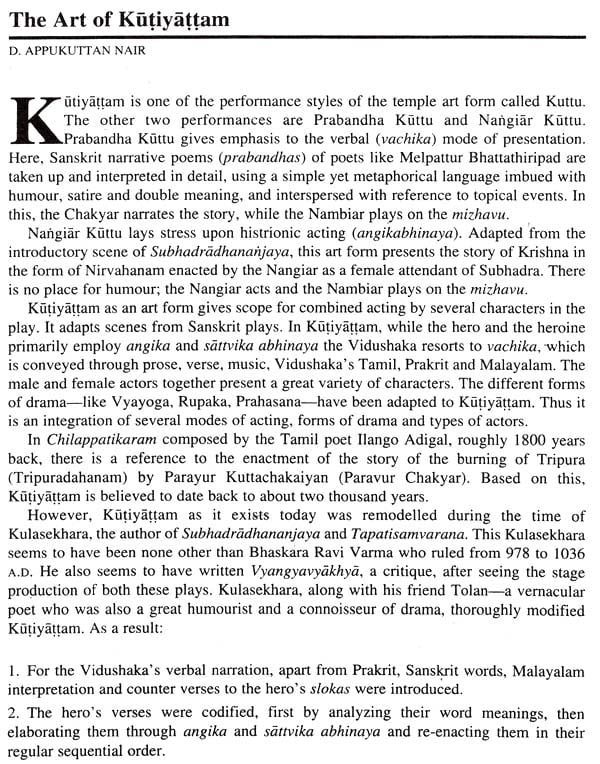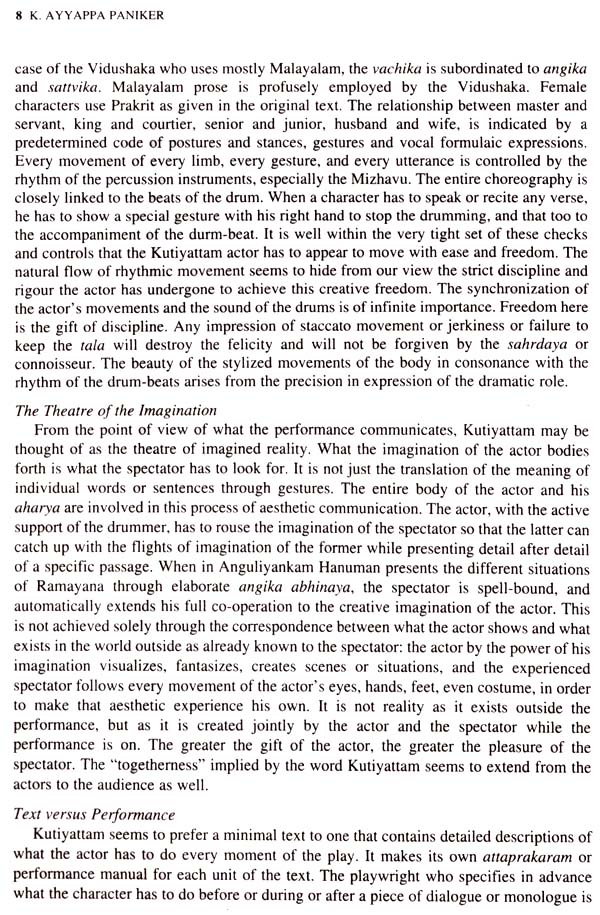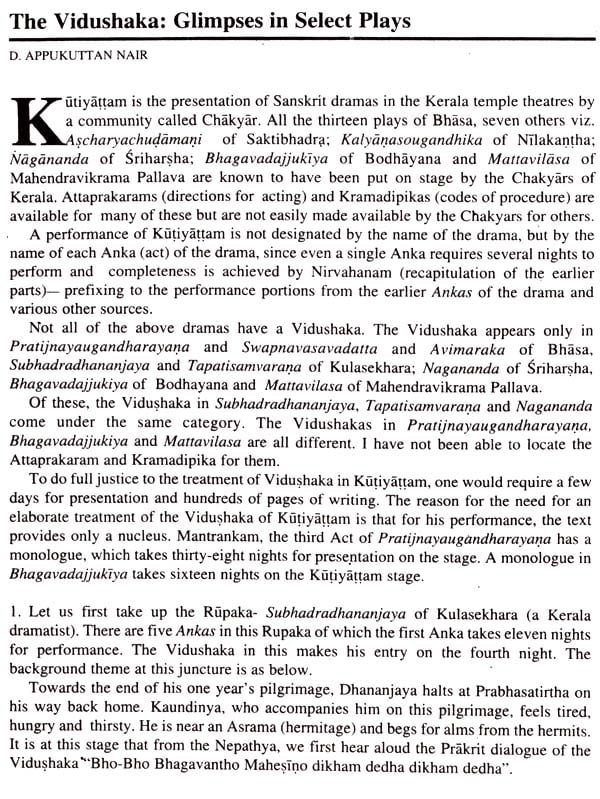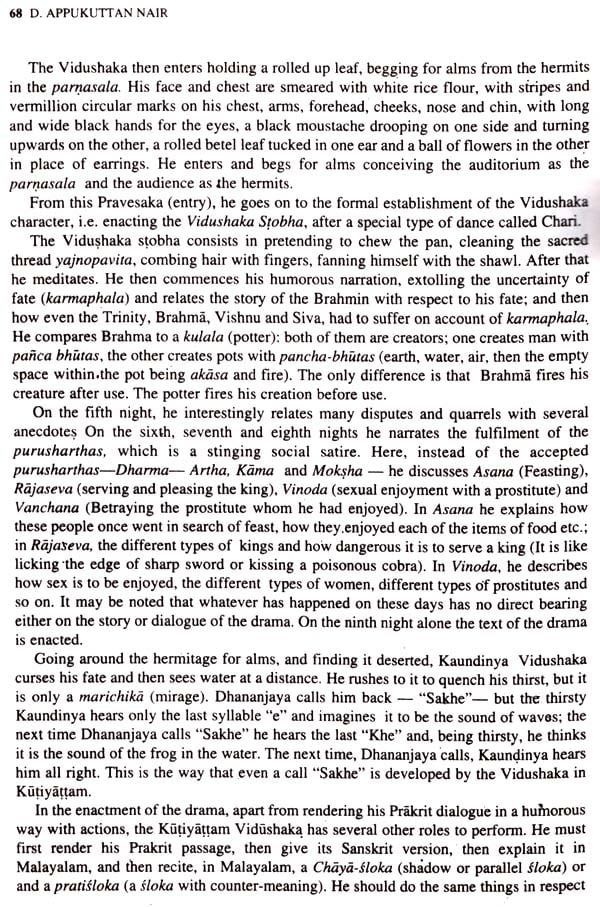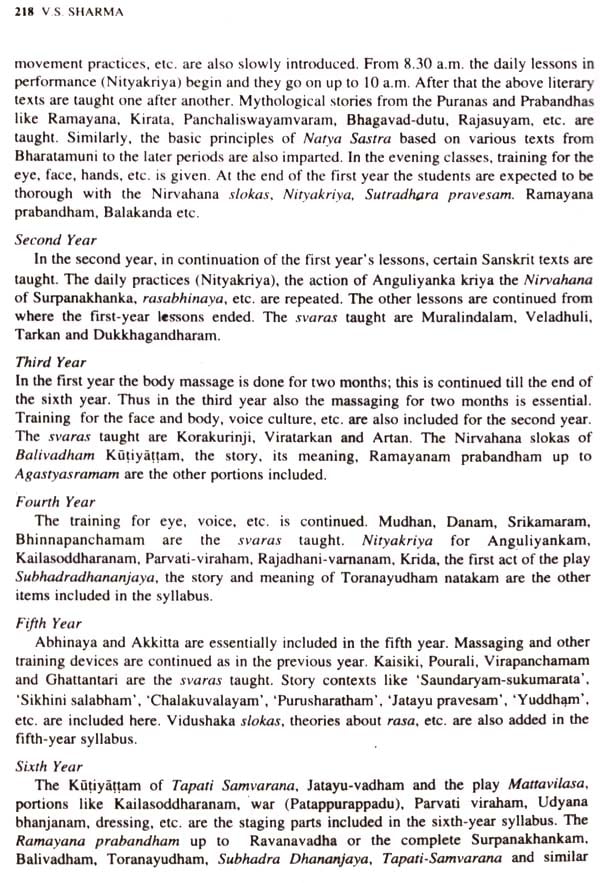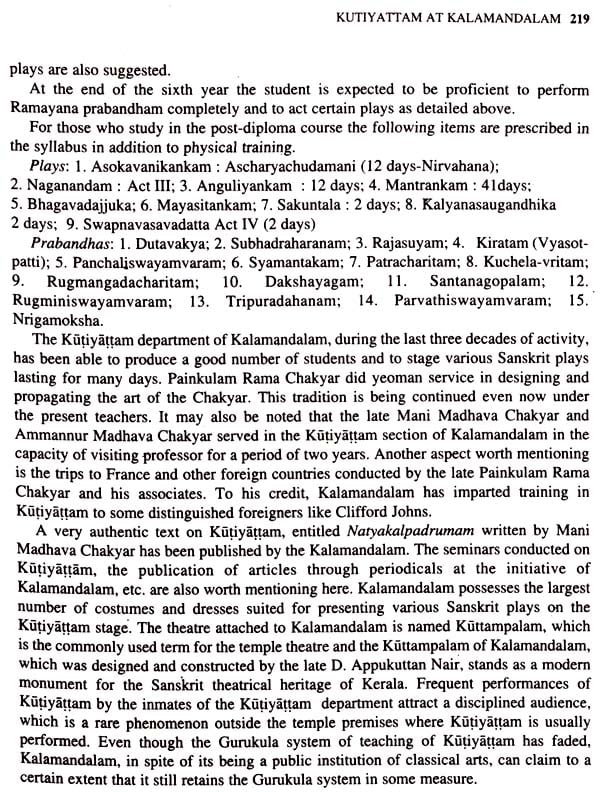
Sangeet Natak - Special Issue on Kutiyattam
Book Specification
| Item Code: | NAP523 |
| Author: | A Chatterjee |
| Publisher: | SANGEET NATAK AKADEMI |
| Language: | English |
| Pages: | 248 (12 B/W and 15 Color Illustrations) |
| Cover: | Paperback |
| Other Details | 9.5 inch X 7.0 inch |
| Weight | 710 gm |
Book Description
What Kutiyattam is and what it is not
Kutiyattam is often defined as the traditional presentation of classical Sanskrit drama on the Kerala stage. It is also frequently described as the only surviving form of the Sanskrit theatre tradition in the whole of India. Sometimes it is also claimed that it is the most authentic and pristine form of ancient Indian theatre. These statements are perhaps not wholly incorrect: but they tell us either too much or too little about Kutiyattam. They are at best partial definitions and imperfect evaluations. They do give us some ideas about Kutiyattam, especially what it appears to be on the surface. But they do not tell us what is distinctive and unique about this theatre. They try to give us the impression that Kutiyattam has existed for a thousand years or more in the same .form in which we find it today. If "traditional," "Sanskrit and "Kerala" are the operative terms; the first should refer to its long history, the second to the language used, and the third to the locale of the performance. One has to go beyond these parameters to get a more precise knowledge of this theatre style and its tradition.
The Malayalam word kiuiyiutam may be taken literally to mean ensemble acting. Kiai means "together" and iittam refers to acting or dancing: rhythmic and stylized movement. But this literal meaning also does not go very far. It gives us very little information about the complexity and sophistication of this performing art. That it uses cenes and situations from Sanskrit plays is true. Often it confines its attention to single acts or scenes-not to a whole play. And even a single act may take as many as 20 or 30 or 40 nights. Many scenes are presented as solo performances, without many actors appearing on the stage together, but with the same actor impersonating several characters without change of costume or make-up. So if someone takes Kutiyattam to mean kiaiyauam, that is, elaborate acting or extended performance, there is some justification for it. Actors are free to go beyond the verbal text of the playas written by the playwright and bring in related episodes from other texts. When the characters recite verses, whatever be their source, they do so in a very specialized and stylized manner. The movements o (the body and the gestures of the hands are highly codified. Netrabhinaya or the movements of the eyes and eyebrows as well as facial expressions are endowed with a lot of significance. Make-up and costume as well as stage decor are conditioned by rigid specifications. There are ritualistic enactments which may not have any obvious or intimate connection with the text of the play concerned. Excessive stylization may at times obscure the connection between the actor's gestures and speeches on the one hand and the body movement and vocal utterances in real life on the other. Realism on the surface is thus kept to the minimum. The emphasis is thus shifted to imagined reality. And all the stage conventions are aimed at projecting this imagined reality. In other words, natyadharmi is allowed to subsume, though not to displace, lokadharmi. In the use of language too, except in the case of the Vidushaka who u as mostly Malayalam, the vachika is subordinated to angika and sattvika. Malayalam prose is profusely employed by the Vidushaka. Female characters use Prakrit as given in the original text. The relationship between master and servant, king and courtier, enior and junior, husband and wife, I indicated by a predetermined code of postures and stances, gestures and vocal formulaic expressions. Every movement of every limb, every gesture, and every utterance is controlled by the rhythm of the percussion instruments, especially the Mizhavu. The entire choreography is closely linked to the beats of the drum. When a character has to speak or recite any verse, he has to show a special gesture with his right hand to stop the drumming, and that took to the accompaniment of the drum-beat, It is well within the very tight set of these checks and control that the Kutiyattam actor has to appear to move with ea e and freedom. The natural flow of rhythmic movement seems to hide from our view the strict discipline and rigor the actor has undergone to achieve this creative freedom. The synchronization of the actor's movements and the sound of the drums are of infinite importance. Freedom here is the gift of discipline. Any impression of staccato movement or jerkiness or failure to keep the taLa will de troy the felicity and will not be forgiven by the sahrdaya or connoisseur. The beauty of the stylized movements of the body in consonance with the rhythm of the drum-beats arises from the precision in expression of the dramatic role.
The Theatre of the Imagination From the point of view of what the performance communicates, Kutiyattam may be thought of as the theatre of imagined reality. What the imagination of the actor bodiesforth is what the spectator has to look for. It is not just the translation of the meaning of individual words or sentences through gestures. The entire body of the actor and his aharya are involved in this process of aesthetic communication. The actor, with the active support of the drummer, has to rouse the imagination of the spectator so that the latter can catch up with the flights of imagination of the former while pre enting detail after detail of a specific passage. When in Anguliyankam Hanuman presents the different situation of Ramayana through elaborate angika abhinaya, the spectator is spell-bound, and automatically extends hi full co-operation to the creative imagination of the actor. This is not achieved solely through the correspondence between what the actor hows and what exist in the world out idea as already known to the spectator: the actor by the power of his imagination vi unalike , fantasize , creates scenes or situations, and the experienced spectator follows every movement of the actor's eyes, hands, feet, even costume. in order to make that aesthetic experience his own. It is not reality as it exists outside the performance. but as it is created jointly by the actor and the spectator while the performance is on. The greater the gift of the actor. the greater the pleasure of the spectator. The "togetherness" implied by the word Kutiyattam seems to extend from the actors to the audience as well.
Text versus Performance
Kutiyattam seems to prefer a minimal text to one that contains detailed descriptions of what the actor has to do every moment of the play. It makes its own attaprakaram or performance manual for each unit of the text. The playwright who specifies in advance what the character has to do before or during or after a piece of dialogue or monologue is not the ideal playwright for the Kutiyattam theatre. Hence Bhasa with his under-worded laconic text or minimal verbal structure is preferred to Kalidasa who seldom forgets to tell thereader/spectator what each character at any given moment is thinking or doing. He leaves little space for the actor to improvise. This may be because Kalidasa is taken primarily as a poet andhis text as more narrative than dramatic. Working with a minimal text the Kutiyattam player can find occasions to add his own imaginative elaborations. This is probably the reason for Bhasa's popularity on the Kutiyattam stage. The attempt to present imagined reality taxes and teases the imagination of the actor as well as theperson who prepares the attaprakaram. Ideally there is no text without performance: in fact, it is the performance that determines the text. In Kutiyattam it seems the performance.
is the real text. An over-written or verbose text is often a hindrance to performance. The elaboration is the contribution of the performer. It is achieved in a number or ways. One of them is the narration of the events starting at some point in the past and leading up to a particular point in time. Another device is the narration in reverse: from the present moment back to some point of time in the past. A third is the narration entirely through gesticulation without the actor or actress speaking. A fourth means of elaboration is the explication or illustration by narrating an implied story within a story. The purpose of all this elaboration is to dramatize an interesting event or anecdote which may be interesting in itself, although it may not be an integral part of the main plot. In fact. Kutiyattam is seldom concerned with the mere telling of a particular story from beginning to end, so as to entertain the audience with the whole play at one sitting. It delights in delaying, deferring the end. Invented episodes are dwelt upon by the Vidushaka, for instance, like an inveterate storyteller, using all his inventive skill to bring in stories from outside the paranoiac context of the play, which he is supposed to be presenting. The author of Natankusa objects to all these types of elaboration, which are of the very essence of Kutiyattam. Just as the Kutiyattam spectator accepts the convention that Ravana or Hanuman or Jimutavahana has to move in a stylized way, recite his speech in the raga or swaras assigned to it, wear a costume that is most unrealistic, and has to keep to the tale of the drumbeats, he also accepts the technique of elaboration and derives pleasure from it. The minimal text is thus made maximal: the actor collaborates with the playwright, the playwright with the drummer and the costume-designer, in producing the performance text. When the actor pretends to look at the sea which he imagines to be in front of him, the spectator should concede the experience of the pretence, instead of saying there is no sea on the stage. The actor's role implies four types of abhinaya, a term more potent than acting: aharya, vachika, angika and sattvika. The text of a play supplies only the material for vachika, which is only one-fourth; three-fourths of, a performance constitute the contribution of the performer. Kutiyattam is the actor's theatre per excellence.
Contents
| Inlroduction : The Aesthetics of Kutiyattam | 7 |
| GENERAL | |
| The Art of Kutuyattam | 12 |
| Kutiyattam in Temples | 33 |
| Attaprakaram and Kramadipika | 38 |
| Kuttampalam | 44 |
| The Trainin Mehods of Kutiyattam | 48 |
| ACTING | |
| Abhinaya in Kutiyattam | 55 |
| Purvaranga in Kutiyattam vis-avis Natyasastra | 58 |
| Vidushaka in Kutiyattam | 63 |
| The Vidushak : Glimpses in select plays | 67 |
| MUSIC | |
| Vachikabhinaya | 74 |
| Svaras in Kutiyattam | 90 |
| Rhythm and Music | 101 |
| Music in Kutiyattam | 113 |
| MAKE - UP | |
| Aahrya: Make-up and Costume | 123 |
| THE PERFORMERS | |
| The Chakyar Families | 127 |
| Major Kutiyattam Artists and Families | 128 |
| My Training, My Gurus | 141 |
| CRITIQUES | |
| Natankusa: A Critique on Dramaturgy | 147 |
| Kutiyattam and Bhasa | 190 |
| SELECT SCENES | |
| Select Scenes | 195 |
| INSTITUTIONS | |
| Kutiyattam at Kerala Kalamandalam | 217 |
| Ammannur Gurukulam | 220 |
| Mari as a Resourse Center for Kutiyattam | 225 |
| APPENDIX | |
| Glossary | 227 |
| A Selec Bibliography | 234 |
| Directory of Kutiyattam Artistes: 20th Century | 239 |
